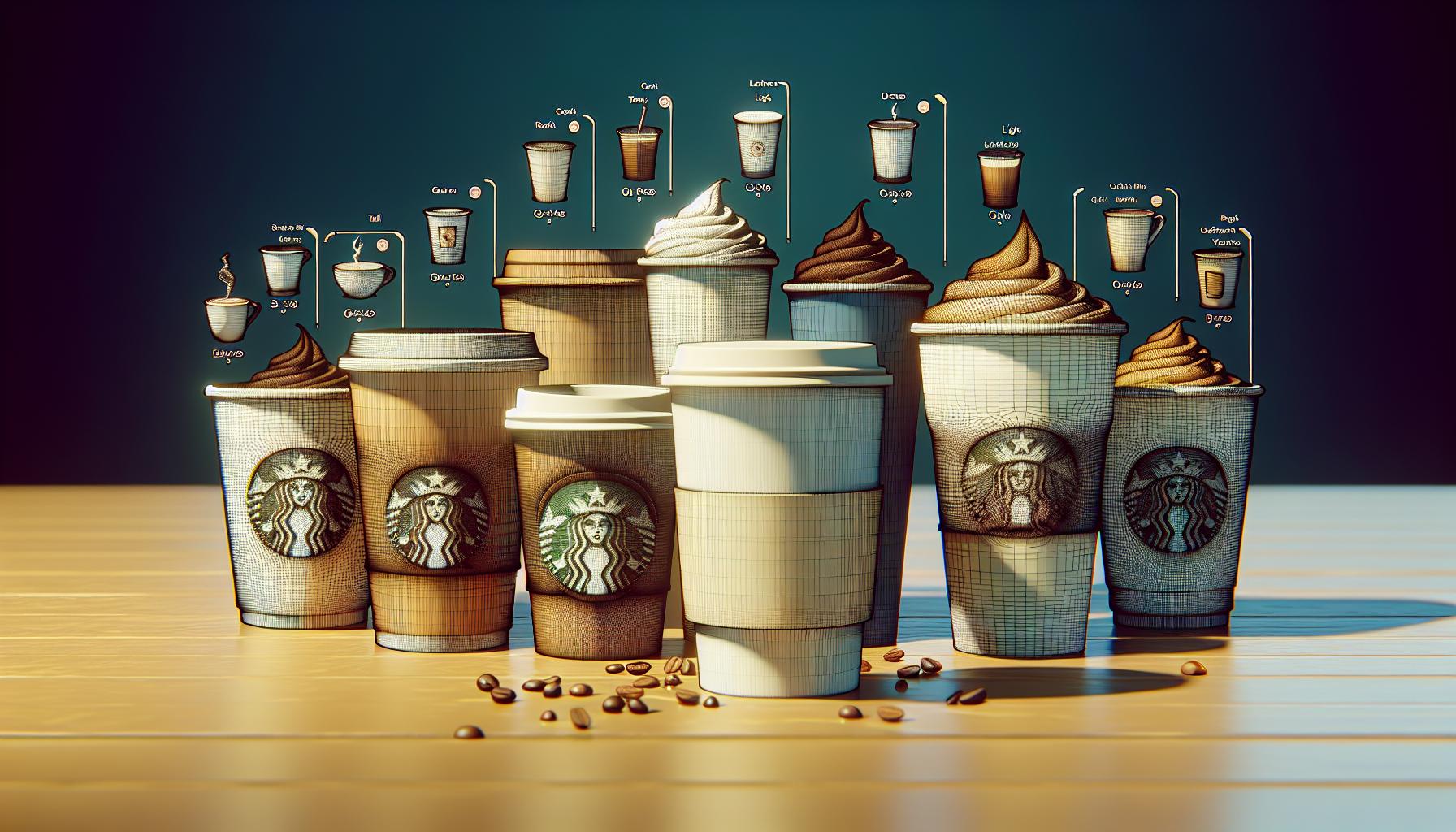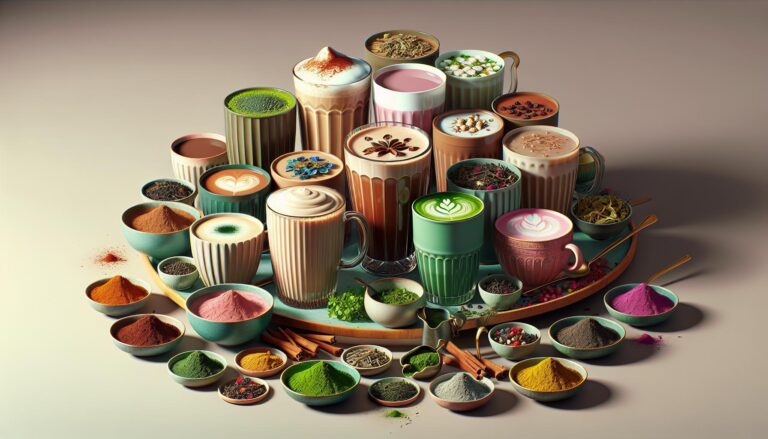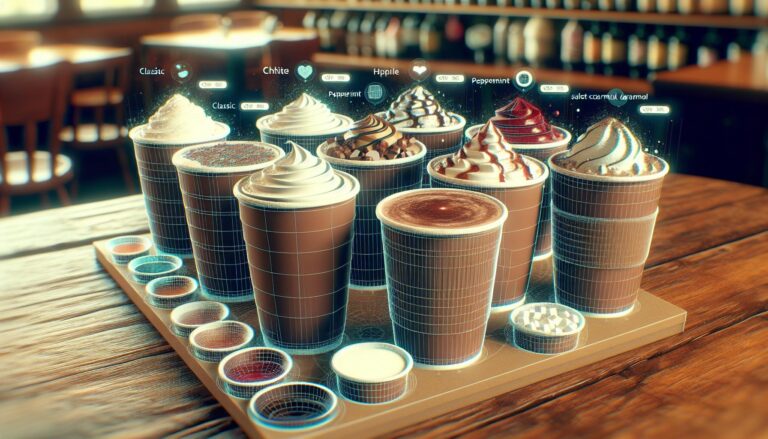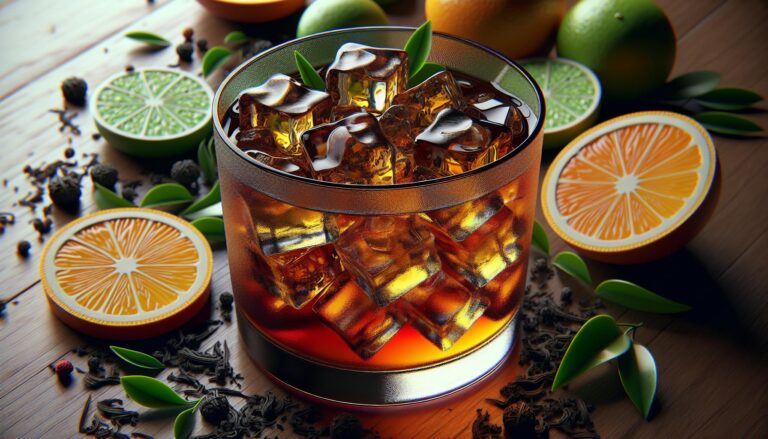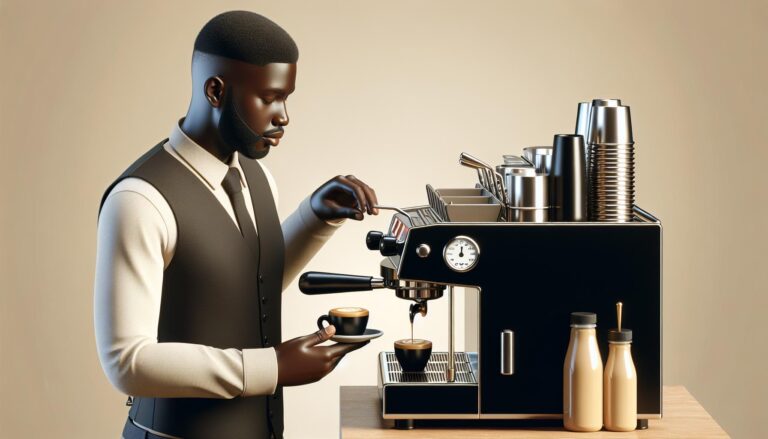Starbucks Coffee Caffeine Content: Your Guide to Informed Choices!
How much caffeine is in Starbucks Coffee? Starbucks, a popular coffee chain, offers a variety of beverages with different caffeine levels. The caffeine content of brewed coffee at Starbucks varies depending on the size of the cup. A Short (8 oz) cup contains 180 mg of caffeine, a Tall (12 oz) cup has 260 mg, and a Grande (16 oz) cup includes 330 mg.
This information is essential for coffee enthusiasts who want to manage their caffeine intake while enjoying their favorite Starbucks beverages.
Explore the details and discover just how much caffeine your favorite Starbucks coffee packs.
Key Takeaways
- Caffeine Content Varies by Drink: Starbucks offers a wide range of beverages with varying caffeine levels, from high-caffeine options like Blonde Roast to milder choices like lattes.
- Influencing Factors: The caffeine content in Starbucks coffee is influenced by the type of bean, brewing method, drink size, and specific coffee blend.
- Health Implications: Moderate caffeine consumption can boost alertness, physical performance, and mood, but excessive intake can lead to insomnia, rapid heart rate, anxiety, and digestive issues.
- Bean Choice and Roasting: Light roasts like Starbucks Blonde Roast have higher caffeine levels than darker roasts due to the roasting process burning off some of the caffeine.
- Brewing Techniques: Different brewing techniques affect caffeine content; cold brew and drip coffee generally have more caffeine than espresso-based drinks due to longer extraction times.
Understanding Starbucks Coffee Caffeine Content
Knowing how much caffeine is in Starbucks coffee helps you make better choices about what to drink. Different factors affect the caffeine content in each beverage.
What Determines Caffeine Levels?
The type of coffee bean used impacts caffeine content. Robusta beans have twice as much caffeine as Arabica beans. The brewing method also affects caffeine levels.
Drip coffee has more caffeine than espresso because of its longer brewing time. The size of the drink matters. Larger drinks have more caffeine than smaller ones.
The specific coffee blend can also play a role. For example, dark roasts often have slightly less caffeine because of the roasting process.
Comparing Caffeine Content Across Starbucks Products
Here’s a quick look at the caffeine content in some popular Starbucks drinks:
| Starbucks Drink | Caffeine Content (mg) |
|---|---|
| Pike Place Roast | 310 (Grande) |
| Blonde Roast | 360 (Grande) |
| Cold Brew Coffee | 205 (Grande) |
| Caffè Americano | 225 (Grande) |
| Latte (regular) | 150 (Grande) |
| Cappuccino | 150 (Grande) |
| Espresso | 75 (Single shot) |
| Starbucks Doubleshot | 225 (Grande) |
These values can help you pick a drink that matches your caffeine needs. If you prefer a milder option, try a latte or cappuccino. For a stronger kick, opt for the Blonde Roast or Pike Place Roast.
For those looking to avoid caffeine, Starbucks also offers decaf brewed coffee, which provides the same great taste without the caffeine.
Read Also: Starbucks Caffeine Content
Popular Starbucks Beverages and Their Caffeine Levels
Explore the caffeine content of popular Starbucks drinks. Knowing these levels helps you choose a beverage that suits your caffeine preference.
Espresso-Based Drinks
Espresso-based drinks offer varied caffeine levels. A single shot of Starbucks espresso contains 75 mg of caffeine. Common espresso-based drinks and their caffeine levels include:
- Latte (16 oz): 150 mg (contains two espresso shots)
- Cappuccino (16 oz): 150 mg (contains two espresso shots)
- Flat White (16 oz): 195 mg (contains three ristretto shots)
- Macchiato (16 oz): 150 mg (contains two espresso shots)
- Americano (16 oz): 225 mg (contains three espresso shots)
Brewed Coffees and Blends
Brewed coffees and blends generally have higher caffeine content. The caffeine levels for popular brewed options are:
- Pike Place Roast (16 oz): 310 mg
- Blonde Roast (16 oz): 360 mg
- Dark Roast (16 oz): 260 mg
- Caffe Misto (16 oz): 150 mg (half coffee, half steamed milk)
- Iced Coffee (16 oz): 165 mg
- Iced Latte (16 oz): 150 mg (contains two espresso shots)
- Cold Brew Coffee (16 oz): 200 mg
- Nitro Cold Brew (16 oz): 280 mg
In addition to coffee, Starbucks offers a variety of iced teas, which are a refreshing alternative with varying caffeine levels.
Also Read: Starbucks Latte Caffeine Content
Health Implications of Caffeine in Coffee
Understanding the health implications of caffeine in coffee can help you make better decisions about your Starbucks coffee choices. Caffeine affects your body in several ways, each with its benefits and downsides.
Benefits of Moderate Caffeine Consumption
Moderate caffeine consumption offers multiple health benefits that can positively impact your daily life.
- Increased Alertness: Caffeine helps improve focus and concentration by stimulating your central nervous system. Drinking a cup of Starbucks coffee in the morning can keep you awake and alert.
- Improved Physical Performance: Caffeine boosts adrenaline levels, which can enhance physical performance. Athletes often use it to gain an edge during workouts or competitions.
- Mood Enhancement: Caffeine promotes the release of dopamine, the “feel-good” neurotransmitter, which can improve your mood. This can be especially useful if you need a mental boost during a challenging day.
- Enhanced Memory: Studies show that caffeine may improve memory function in the short term. This could be beneficial when you need to retain important information.
Potential Downsides of High Caffeine Intake
Consuming high levels of caffeine can lead to several health issues. Monitoring your intake is essential to avoid these potential downsides.
- Insomnia: Excessive caffeine consumption, especially later in the day, can disrupt sleep patterns. Avoid drinking high-caffeine Starbucks beverages in the evening to minimize this risk.
- Increased Heart Rate: High caffeine levels can cause rapid heart rate or palpitations. People prone to heart problems should be cautious about their caffeine intake.
- Anxiety: High doses of caffeine can trigger anxiety and restlessness. If you’re sensitive to caffeine, consider opting for lower-caffeine options like a latte or tea.
- Digestive Issues: Overconsumption of caffeine can lead to digestive problems, such as acid reflux or stomach upset. Moderating your intake can help maintain digestive health.
For those looking to avoid caffeine-related issues, Starbucks’ hot chocolate is a delicious, caffeine-free option.
Read Also: Starbucks Cappuccino Caffeine Content
How Starbucks Adjusts Caffeine Content in Decaf Brewed Coffee
Starbucks tailors the caffeine content in drinks to meet diverse preferences by adjusting various factors. You can better understand how your coffee’s caffeine levels are impacted by exploring these elements.
The Role of Bean Choice and Roasting
Bean choice and roasting level directly impact caffeine content at Starbucks. Different bean types contain varying amounts of caffeine.
Arabica beans offer a smoother taste, with less caffeine than Robusta beans. Starbucks primarily uses Arabica beans which have less bitterness.
The roasting level also affects caffeine content. Light roasts like Starbucks Blonde Roast have higher caffeine levels than darker roasts.
The roasting process burns off some caffeine; thus, the longer the beans roast, the less caffeine remains. Choose light roasts if you prefer higher caffeine.
Brewing Techniques and Their Impact on Caffeine
Brewing techniques significantly affect the caffeine content in Starbucks coffee. For instance, espresso-based drinks concentrate caffeine in a small amount of liquid.
An espresso shot has about 75 mg of caffeine, whereas a brewed coffee like Pike Place Roast contains 155 mg in a tall cup (12 oz).
Cold brew coffee brews longer, usually 12-24 hours, resulting in more caffeine. A tall cold brew has around 155 mg of caffeine.
On the other hand, traditional hot brews extract caffeine faster but may contain slightly less due to the shorter brewing time.
Understanding these factors helps you select beverages that align with your caffeine preferences at Starbucks.
Also Read: Starbucks Macchiato Caffeine Content
Conclusion
Understanding the caffeine content in Starbucks beverages helps you make informed decisions about your coffee consumption.
Knowing the factors that influence caffeine levels allows you to choose drinks that align with your preferences and health needs.
By being aware of the caffeine content in various Starbucks offerings, you can enjoy your favorite coffee while managing your intake effectively.
Always consider the type of coffee bean, brewing method, and drink size to find the perfect balance for your daily routine.
Stay alert and enjoy your Starbucks experience responsibly!
Frequently Asked Questions
What factors influence caffeine content in Starbucks drinks?
Several factors influence caffeine content in Starbucks drinks, including the type of coffee bean, brewing method, drink size, and coffee blend. These elements collectively determine the caffeine levels in each beverage.
How does the type of coffee bean affect caffeine content?
The type of coffee bean significantly impacts caffeine content. For example, Arabica beans have less caffeine than Robusta beans. Starbucks commonly uses Arabica beans, which are known for their flavor and relatively lower caffeine levels.
Do brewing methods alter the caffeine levels in Starbucks beverages?
Yes, the brewing method plays a crucial role. Methods like cold brew result in higher caffeine content compared to standard drip brewing. Espresso-based drinks also vary in caffeine levels depending on the number of shots used.
How does drink size impact caffeine content at Starbucks?
Drink size directly affects caffeine content. Larger sizes contain more caffeine because they hold a greater volume of coffee. For instance, a venti-sized drink will have more caffeine than a tall or grande-sized drink.
Which Starbucks drink has the highest caffeine content?
The Blonde Roast generally has the highest caffeine content among regular brewed coffees at Starbucks. Cold Brew Coffee and certain espresso-based drinks with multiple shots also feature high caffeine levels.
What is the caffeine content in popular Starbucks drinks like Latte, Americano, and Chai Tea Latte?
A standard Grande Latte has about 150 mg of caffeine, while a Grande Americano contains roughly 225 mg. The exact content can vary based on additional shots of espresso or drink modifications.
Are there any health benefits to moderate caffeine consumption?
Moderate caffeine consumption can enhance alertness, improve physical performance, boost mood, and enhance memory. These benefits make caffeine a popular choice for many consumers.
What are the potential downsides of high caffeine intake?
High caffeine intake can lead to insomnia, increased heart rate, anxiety, and digestive issues. Monitoring and moderating your caffeine intake is essential to avoid these health risks.
For a tasty, non-caffeinated treat, try Starbucks’ Vanilla Bean Crème Frappuccino.
How does Starbucks adjust the caffeine content in their drinks?
Starbucks adjusts caffeine content by selecting different types of beans, varying roasting levels, and employing specific brewing techniques. These adjustments help cater to a wide range of caffeine preferences among customers.

